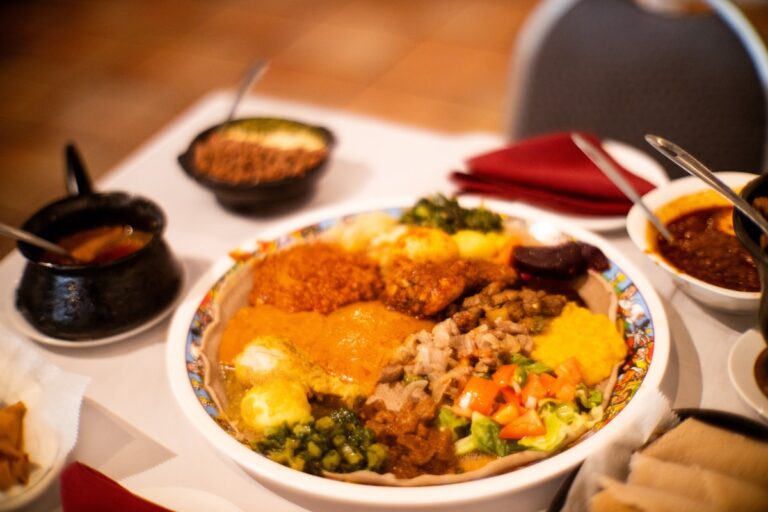Ethiopian cuisine is a big part of the rich and complex food and drink scene in and around the capital city.
“I don't know who told me about America or where I learned about it, but I always said, 'I'm going to America,'” Elsabete Ilge, chef and co-owner of Elsa Ethiopian Kitchen, told me as we munched on a large communal tray of traditional Ethiopian dishes served the traditional way on injera bread.
Of the many immigrant groups with deep roots in the region, Ethiopians have an original arrival story that vividly illustrates how America has been a beacon for suffering people around the world. Nearly two decades of civil war and years of famine forced millions to flee and be persecuted. Benefiting from the landmark 1980 Refugee Act, Ethiopians fled to the United States, with the majority settling in the Washington Metropolitan Area.
For many years, the region has claimed to have the best Ethiopian cuisine in the country.
At Elsa, the focus is on preserving the authenticity of Ethiopian cuisine, rather than tweaking it, when it comes to bringing it to Americans.
The menu also features some hard-to-find dishes, such as kitfo, an Ethiopian steak tartare.
As well as traditional doro wat chicken stew.
In the early days, many traditional ingredients were nearly impossible to source, but Beniam Belay, Ilge's husband and business partner, says even teff, the ancient gluten-free grain needed to make injera, is now grown locally.
In the Washington area, where there is a large Ethiopian immigrant community, non-Ethiopian customers have come to expect authentic flavors.
Jason Rezaian: What are the challenges of running a restaurant as an immigrant?
Elsabeth Ilge: There are no special challenges. The challenges are all the same. You have to build a business. You have to work hard, especially when starting a new business. You're working double shifts. Paying your staff is hard. You have to have everything covered for your employees.
My first customer was a miracle. Nobody knew me. For the first month, I cooked one or two dishes and that was it. Then, after the first month, it was time to fast. [before Easter]I started cooking dairy-free, egg-free, basically vegan food, and all my Ethiopian customers started talking about my food and loved it.
But in this place, most of my customers are not Ethiopian, there are different people living in this area, and also tourists from the hotels because it is home to the National Zoo.

How do you connect with non-Ethiopian customers? What are the most popular dishes?
Ilge: I think the dish is tibs. We all know beef, we know lamb. We add onions, jalapenos, tomatoes, spices. If you've never had Ethiopian food, I recommend the veggie combo, which is one meat and one vegetable. The one meat is usually tibs, and it's all served on injera bread.

Beniam belay: To me, authenticity means doing it the original, traditional way. I talk to a lot of people, and they want authenticity. When you come here, you really want to eat Ethiopian food, not Americanized food. We make it 100 percent the same way. The only thing we change a little bit is we cut back on the spices. We're not here to make people sweat.
Ilge: All of the food we cook is Ethiopian style.
What ingredients do you need to make a dish that aren't readily available here?
Ilge: Back home, everything is organic, so the taste is a little different, the spices too, but here you can get everything, most of it comes from Mexico and India. [the spice mix] berbere — we make it here.
Belaying: Well, you know, the world is connected. Anything you want is available right now. Anything. Even Ethiopian spices. And it's easy to make and mix. You can buy a little grinder online. Just like you do back home.
Is there a smell or dish that reminds you of home?
Ilge: It's roasted coffee. And it's incense. We roast our coffee at home, right? We brew it in clay pots. And when we brew the coffee, we have to invite the whole neighborhood.


What dish most symbolizes Ethiopia to you?
Ilge: Doro ot is chicken and eggs served with a spicy berbere sauce, or a milder version. I used to eat this on holidays when I was a child, and whenever we had guests over, I would make it.
They also have a raw beef called kitofo, but they add mitomita to it. Mitomita is hot like cayenne pepper, but it's made differently. Not many people here order it raw. You can cook it a little, but it tastes better raw.
The map shows African restaurants in Washington DC.
Elsa Ethiopian Kitchen
2614 Connecticut Ave NW, Washington, DC (202) 290-2948. elsaethiopiankitchen.com
Opening hours: Monday, 4pm to 10pm, Tuesday to Sunday, daily 11am to 10pm.
Post Opinions wants to know: What food or ingredient reminds you of your own childhood or where you grew up? Share your thoughts with us.








